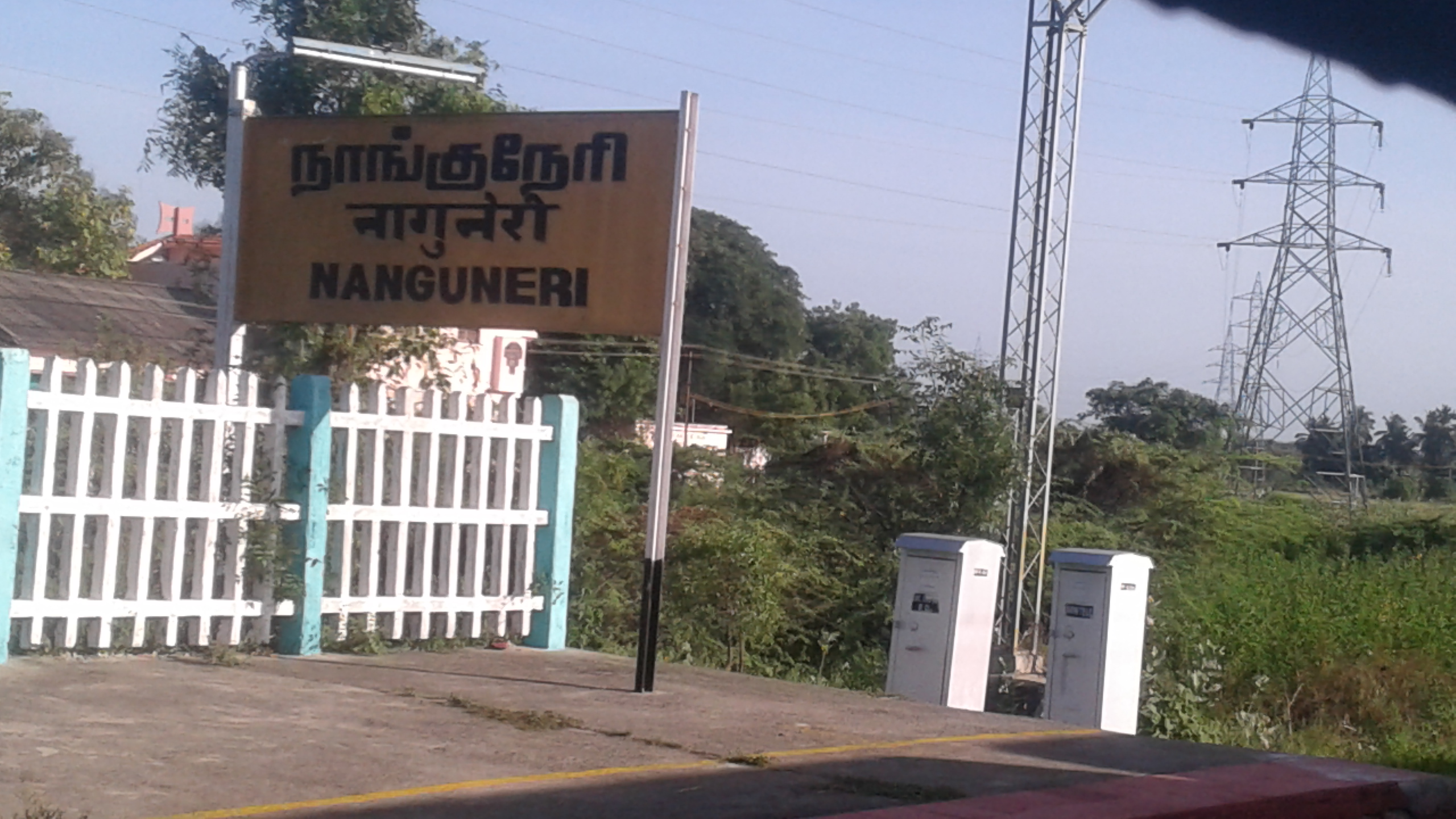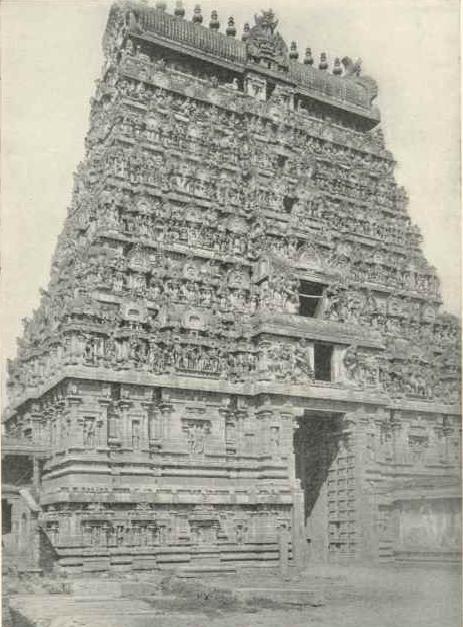|
Satani (caste)
Satani is a Vaishnavite community who render temple services in the states of Andhra Pradesh, Karnataka, Tamil Nadu and Telangana in India. Traditionally, they have rendered a variety of services as supervisors and purohits of minor temples, guardians of temple properties, heralds, singers and torch-bearers at festivals, bodyguards of Jiyars, and providers of umbrellas, flower garlands, and namam clay. They have claimed Brahmin status, although this has been contested by Brahmins as they do not wear the sacred thread. Etymology The name 'Satani' is supposed to be a corruption of 'chyatani' or 'chyati' which means "acting according to prescribed rites". Satani is also said to be the shortened form of Sattadavan/Satanivadu, meaning the uncovered man or the one who does not wear. They are prohibited from covering three different parts of their bodies, viz., the head with Sikha, the body with the sacred thread, and the waist with the customary strip of cloth. Origin/History In socia ... [...More Info...] [...Related Items...] OR: [Wikipedia] [Google] [Baidu] |
South India
South India, also known as Dakshina Bharata or Peninsular India, consists of the peninsular southern part of India. It encompasses the Indian states of Andhra Pradesh, Karnataka, Kerala, Tamil Nadu, and Telangana, as well as the union territories of Lakshadweep and Puducherry, comprising 19.31% of India's area () and 20% of India's population. Covering the southern part of the peninsular Deccan Plateau, South India is bounded by the Bay of Bengal in the east, the Arabian Sea in the west and the Indian Ocean in the south. The geography of the region is diverse with two mountain ranges – the Western and Eastern Ghats – bordering the plateau heartland. The Godavari, Krishna, Kaveri, Tungabhadra, Periyar, Bharathappuzha, Pamba, Thamirabarani, Palar, and Vaigai rivers are important perennial rivers. The majority of the people in South India speak at least one of the four major Dravidian languages: Tamil, Telugu, Malayalam and Kannada (all 4 of which are among the 6 Classic ... [...More Info...] [...Related Items...] OR: [Wikipedia] [Google] [Baidu] |
Manavala Mamunigal
Alagiya Manavalan, best known by his epithet Manavala Mamunigal (1370–1450), was a Hindu theologian. He was a major proponent of the Sri Vaishnavism tradition in the 15th century in Tamilakam, disseminating it with the help of his eight disciples. The disciples of Manavalan established places of learning to teach the Vishishtadvaita philosophy in Tamilakam. ''Yathindra Pravana Prabhavam'' by Pillai Lokam Jeeyar is the earliest work on which scholars and historians rely for information for the biography of Manavala Mamunigal. Life Manavala Mamunigal was born in 1370 at Alwarthirunagiri in Tamil Nadu. His parents were Tigalakidanthan Tirunaveerudaiya Piran Tadar Annar and Sriranga Nachiyar. His father was the son-in-law and also a disciple of Kollikavala Dasar, a junior disciple of Pillai Lokacharya. His parents named him ''Alagiya Manavalan'' (beautiful groom) after the deity Ranganathaswamy of Srirangam. Manavalan was schooled by father and maternal grandfather, who taug ... [...More Info...] [...Related Items...] OR: [Wikipedia] [Google] [Baidu] |
Tirupati
Tirupati () is a city in the Indian state of Andhra Pradesh. It is the administrative headquarters of the Tirupati district. The city is home to the important Hindu shrine of Tirumala Venkateswara Temple and other historic temples and is referred to as the "Spiritual Capital of Andhra Pradesh". It is located at a distance of 150 km from Chennai, 250 km from Bangalore and 415 km from Amaravati. It is one of the eight ''Swayam vyaktha kshetras'' (''Self-Manifested Temples'') dedicated to Vishnu. Tirupati is a municipal corporation and the headquarters of Tirupati (urban) mandal, Tirupati (rural) mandal, and the Tirupati revenue division. It is the 7th most urban agglomerated city in the state, with a population of in 2011 and around 1,004,615 in 2021. census, it had a population of 287,035 making it the 9th most populous city in Andhra Pradesh. It is the second biggest city in Rayalaseema after Kurnool. For the year 2012–2013, India's Ministry of Tourism n ... [...More Info...] [...Related Items...] OR: [Wikipedia] [Google] [Baidu] |
Nanguneri
Nanguneri is a panchayat town in Tirunelveli district in the Indian state of Tamil Nadu. Nanguneri is a Taluk Headquarters in the District of Tirunelveli situated at a distance of from the headquarters of the District. Vanamamalai Perumal temple located here, is a Vaishnavite Shrine also known as Arulmigu Sree Vanamamalai Totatri Perumal Temple or more commonly known as Totadri Mutt. Geography Nanguneri is located at . It has an average elevation of 141 meters (462 feet). Demographics India census, Nanguneri had a population of 6,764. Males constitute 49% of the population and females 51%. Nanguneri has an average literacy rate of 76%, higher than the national average of 59.5%: male literacy is 83%, and female literacy is 70%. In Nanguneri, 10% of the population is under 6 years of age. Community and culture Politics Nanguneri assembly constituency is a part of Tirunelveli (Lok Sabha constituency). Landmarks Vanamamalai Perumal temple located here, is a Vais ... [...More Info...] [...Related Items...] OR: [Wikipedia] [Google] [Baidu] |
Srirangam
Srirangam, is a neighbourhood in the city of Tiruchirappalli in the Indian state of Tamil Nadu. A river island, Srirangam is bounded by the Kaveri River on one side and its distributary Kollidam on the other side. Considered as the first among the 108 Divya Desams, Srirangam is home to a significant population of Sri Vaishnavites (followers of Lord Vishnu). Sri Ranganathaswamy Temple Srirangam is famous for its Sri Ranganathaswamy Temple, a major pilgrimage destination for Hindus (especially Srivaishnavites) and the largest temple complex in India. According to the temple's website, Srirangam is considered the biggest functioning Hindu temple in the world, as it covers an area of about with a perimeter of 4 km (10,710 ft). Angkor Wat is bigger but non-functioning. Srirangam among a few " self-manifested" shrines (Swayam Vyakta Kshetras) of Lord Vishnu. The temple complex is enormous and spans . It has seven ''prakaras (enclosures). These enclosures are fo ... [...More Info...] [...Related Items...] OR: [Wikipedia] [Google] [Baidu] |
Samasrayana
{{Hindu philosophy Samasrayana or Pancha Samskara (meaning Five Purifications) is a Pañcaratra rite practiced in all forms of Vaishnavism. Samasrayana means 'to approach with all sincerity and truthfulness to Acharya'. During this rite, the acharya initiates a person, irrespective of sex, caste, social status etc., as his or her sishya. It is a commitment from the disciple that he or she will live as per the wishes of the acharya. Thus, the person gets the link to the Vaishnava tradition. Samasrayana consists of the guru bringing the initiate into the srivaishnava ''flock'' through five steps: (1) thapaha-embossing the impression of Vishnu's sudarshana discus on the right shoulder of the initiate and of Vishnu's panchajanya conch on the left shoulder of the initiate - using an ember-heated silver seal; (2)pundraha-introducing the twelve locations in the body where Vishnu resides and thus are to be marked with the Vaishnava tilak sign; (3)dasaha tatha namaha-adding the suffix d ... [...More Info...] [...Related Items...] OR: [Wikipedia] [Google] [Baidu] |
Nammalvar
Nammalvar (Tamil: நம்மாழ்வார், lit. 'Our Alvar') was one of the twelve Alvar saints of Tamil Nadu, India, who are known for their affiliation to the Vaishnava tradition of Hinduism. The verses of the Alvars are compiled as the Naalayira Divya Prabandham, where praises are sung of 108 temples that are classified as divine realms, called the Divya Desams. Nammalvar is considered to be the fifth in the line of the twelve Alvars. He was born in a Shudra family, but his pursuit of knowledge accorded him the respect of a Brahmin. He is highly regarded as a great mystic of the Vaishnava tradition. He is also considered to be the foremost among the twelve Alvars, and his contributions amount to 1352 among the 4000 stanzas in the ''Naalayira Divya Prabandam''. According to traditional scriptures, Nammalvar was born in 3059 BCE in Alwarthirunagiri; historically he flourished in 8th century CE. In Hindu legends, Nammalvar remained speechless from the moment of his b ... [...More Info...] [...Related Items...] OR: [Wikipedia] [Google] [Baidu] |
Naamam
The Srivaishnava Urdhva Pundra (Alternatively referred to as ''Thiruman'', ''Sricharanam'', or ''Namam'') is the tilak worn by the adherents of Sri Vaishnavism. The figure drawn is representative of the feet of Narayana with the goddess Lakshmi featured in the middle. Form The original tilak The two Iyengar denominations, the Tenkalai and the Vadakalai, wear the namam with slightly altered designs. The namam for the adherents of the Tenkalai tradition includes a white bow that extends to the bridge of the nose, shaped like a Y. A red line runs down the middle of this design. This particular tilak is believed to have its origin in the Pancharatra text Ishwara Samhita. The adherents of the Vadakalai tradition wear a similar white bow-shaped design shaped like a U, featured entirely upon the forehead. A red or sometimes yellow line runs down the middle of this design. Priests serving in temples traditionally wear the Thiruman Srichurnam on 12 spots of their body (dvadasa pundram) ... [...More Info...] [...Related Items...] OR: [Wikipedia] [Google] [Baidu] |
Panchajanya
Panchajanya (IAST: Pāñcajanya) is the ''shankha'' or conch of the Hindu preserver deity Vishnu, known to be one of his four divine attributes. It is stated to have been one among the various substances that emerged during the Samudra Manthana. According to the Mahabharata, Purushottama (Vishnu) killed a daitya (a member of a clan of asuras) named Panchajana on a mountain named Chakravan constructed by Vishvakarma, and seized the conch shell in which Panchajana had lived for himself. The conch is named after the daitya. In Literature In the Bhagavad Gita, the Panchajanya is mentioned: As per the Harivamsa, Krishna, the avatar of Vishnu, is described as possessing a conch shell called Panchajanya, one of his four attributes together with the mace Kaumodaki, the disc-like weapon Sudarshana Chakra, and a lotus. The conch was used during the Kurukshetra War, and is held in popular tradition to have signalled its beginning. Origin There are two origins stated in the scriptur ... [...More Info...] [...Related Items...] OR: [Wikipedia] [Google] [Baidu] |
Chakra
Chakras (, ; sa , text=चक्र , translit=cakra , translit-std=IAST , lit=wheel, circle; pi, cakka) are various focal points used in a variety of ancient meditation practices, collectively denominated as Tantra, or the esoteric or inner traditions of Hinduism.Chakra: Religion Encyclopaedia Britannica The concept of the chakra arose in the early traditions of Hinduism. Beliefs differ between the Indian religions, with many Buddhist texts consistently mentioning five chakras, while Hindu sources reference six or seven. Early Sanskrit texts speak of them both as meditative visualizations combining flowers and mantras and as physical entit ... [...More Info...] [...Related Items...] OR: [Wikipedia] [Google] [Baidu] |
Garuda
Garuda (Sanskrit: ; Pāli: ; Vedic Sanskrit: गरुळ Garuḷa) is a Hindu demigod and divine creature mentioned in the Hindu, Buddhist and Jain faiths. He is primarily depicted as the mount (''vahana'') of the Hindu god Vishnu. Garuda is also the half-brother of the Devas, Daityas, Danavas and Yakshas. He is the son of the sage Kashyapa and Vinata. He is the younger brother of Aruna, the charioteer of the Sun. Garuda is mentioned in several other texts such as the Puranas and the Vedas. Garuda is described as the king of the birds and a kite-like figure. He is shown either in a zoomorphic form (a giant bird with partially open wings) or an anthropomorphic form (a man with wings and some ornithic features). Garuda is generally portrayed as a protector with the power to swiftly travel anywhere, ever vigilant and an enemy of every serpent. He is also known as Tarkshya and Vainateya. Garuda is a part of state insignia of India, Indonesia and Thailand. The Indonesian official ... [...More Info...] [...Related Items...] OR: [Wikipedia] [Google] [Baidu] |




.jpg)
